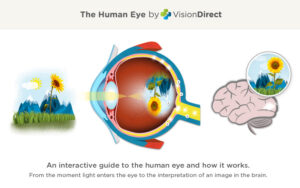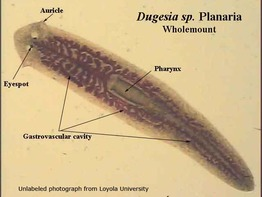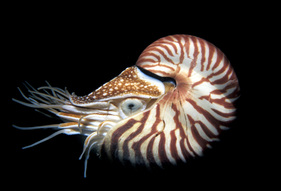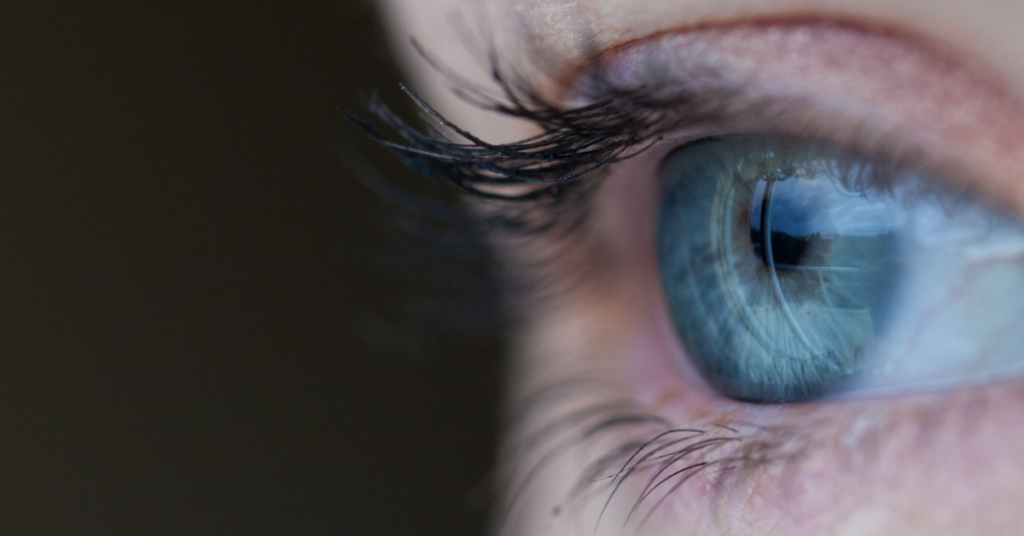One of my least favorite doctor’s visits each year is to the optometrist. I would much prefer to have my teeth cleaned at the dentist (actually I love having my teeth cleaned at the dentist) than go to the eye doctor. And I’m not entirely sure why, other than my eye sight is always getting worse and there is absolutely nothing I can do about it.
I have astigmatism in both eyes so when I take my contacts out, I can’t even see the giant E on the top of the chart! And while it frustrates me to no end to have such terrible vision already, it makes me exceedingly grateful for the vision correction technology that we have. Otherwise, I couldn’t see enough to do much of anything!
But it is also a great reminder of how important – and how fragile – the eye is. It should also prompt us to ask how we got eyes that could function.
From the atheistic perspective, our eyes must be the result of the build up from something simple. In Darwin’s words, every complex organ or system must be the result of a slow, gradual process of “infinitesimally small inherited modifications,” each of them being profitable to the preserved being.[i] Can the human eye be explained in this way?
In one way, we could say that this slow incremental build up could be valid. An organism that has 2% of an eye would be more advantageous than 0%, therefore the organisms with 2% of the eye would survive and the others would be eliminated by natural selection. The population would then need another genetic mutation to gain 4% of the eye, which would be more advantageous than the 2% of the eye. Then those organisms with 4% of the eye would survive to pass along its components, and so forth.
However, there is a major flaw in this approach. Having 2% of the eye does not equate to 2% of eyesight. Although 2% vision is better than 0%, as I am well aware, there is no vision at all until 100% of the eye components are present. There is a difference in a partial percentage of the components of the eye itself and having some partial percentage of eyesight.
In other words, if you only had a cornea, but no pupil, iris, retina, rods, or cones, then you could not see at all. Nothing. 0%. What advantage would an organism have to genetically mutate a cornea, which gives it no sight whatsoever, only to wait around until all of the other organ structures have evolved? Especially considering the population must preserve that genetic change until it mutates all of the other components necessary for sight.
Remember though, each change must be from an infinitesimally small modification (one micro-mutated gene at a time). And each change must give some survival advantage to be preserved by natural selection. But why would natural selection preserve the genes of the organism with a cornea over an organism with no cornea if neither organism could see?
Furthermore, the eye is more complicated than just having the structures for that specific organ. There are many support structures that are necessary for it to function. The eye needs tears and blood to lubricate and nourish the eye; muscles that allow the eye to move; structures that give the eye protection from injury, like the eye lid and the epithelium of the cornea; an optic nerve to send the signals from the eye to the brain; and a brain to understand what those signals mean.
If there were not a brain to interpret what the eye sees, then the eye would still be useless to the organism. One may counter by pointing out that some organisms are able to have eyesight without those support structures and without a brain – but not our eye type.
For our eye type, the camera eye, something must be able to interpret what the eye sees into something meaningful, especially since what our eyes “see” is upside down and double. Our brain is able to combine and convert those double upside-down images into something that makes sense to us. And all of that work is done by multiple parts within the brain.[ii]

If those organ parts evolved without the ability to actually see and interpret what has been seen, the eye would basically just be one annoyance, where dust and particles would scratch and irritate this new feature that didn’t provide any use for the organism. It is hard to imagine why it would be preserved by natural selection before it gave the benefit of vision. It would be like someone giving a smart phone to a farmer in the 1800s. I doubt he would hang onto it until the internet came along.
Granted, there are different types of complexity of eyes that are found in nature. Some bacteria have just a light sensitive spot with a pigment screen behind it. Some multi-cellular animals have a similar arrangement set into an optical cup to give improved direction-finding capability. The nautilus has a pinhole eye with no lens, and then the squid eye adds a lens. There is the simple eye, the compound eye, and the camera eye (human eye).
There is wide variety of eye types with various levels of complexity. Evolutionists think the eye evolved from one type to another until we have our eye type. But could that really happen? It is a pertinent question, especially since all of these eye types co-exist together!
We must first assess the
components of these different eye types. Are the components similar across all
eye types to where there could be an incremental building up of something complex?
In other words, does the simplest eye have just a retina, the next eye adds a
lens, and the next adds a cornea until you find all of the components present
in the most complex eye – where each of those intermediate eyes were fully
functional?
That is not the case at all when you look at the
details. Each of these different eye types uses entirely different structures.
It is not a series of structures that are built upon one another over millions
of generations. For example, the compound eyes of insects are made up of
hundreds of units called ommatidia that have a cluster of photoreceptor cells
surrounded by support cells and pigment cells, each one with its own lens

This is a much different structure than the human eye (pictured below). Those components do not simply gain something new to then become the camera eye. The compound eye needs an entirely different grouping of components. And intermediate eye between these two eye types would be something that could not see
Let’s put the pencil to the paper for the two “simplest” eyes to see if they could genetically mutate from one to the other. Here are the descriptions of these two eye types. [iv]
Pigment cup eyes (found in Planaria):
Cup of dark pigment with only a few photoreceptors. No optical system. Only an opening (aperture) to allow light into the cup. Aperture restricts the width of the cone of light that reaches any one photoreceptor. Very small eyes (0.004 in). Not useful for hunting prey or evading predators.

Pinhole eyes (found in Nautilus):
Larger eyes (0.4 in). Smaller aperture. Has millions of photoreceptors. Has muscles to move the eyes. Pupils that can vary in diameter with light intensity. No lens. Each photoreceptor must cover a wide angle of the field of view. Produces an extremely dim image.
The pinhole eye of the Nautilus is still referred to as an eye of “great size and complexity.”

The evolutionary progression would have to show that the light spot of the Planaria slowly added structures and features to evolve into the pinhole eye of the Nautilus. But the genetic mutations that must are not controlled by the organism itself nor by the environment it is subjected to. Remember for Darwinian evolution to work, those mutations must be blind (pun intended) and random. The organism cannot plan for or anticipate those changes. Nature can’t predetermine the appropriate order for each change to occur. It must all be random.
Let’s look at the incremental changes between these two incredibly “simple” eyes, changing from a Planaria eye to a Nautilus eye. First, the organism would need a genetic mutation to produce millions of photoreceptors instead of just a few. What would a Planaria do if it suddenly had millions of photoreceptors for its pigment cup eye, which only needs a few? That would not give the Planaria any survival advantage since that would not be an improvement in vision.
Then the Planaria’s genes must mutate to decrease the size of the aperture. But how would it be able to still see if the aperture size is decreased while the size of the eye is still only 0.004 inches? Meanwhile, what have all those changes done to the function of the pigment cup eye for the Planaria? Because at this point, the Planaria’s eye is not a pinhole eye. It is a pigment cup eye with too many photoreceptors and too small of an aperture.
Hopefully for the Planaria’s sake the next genetic mutation will be to increase the size of the eye 100 times from 0.004 inches to 0.4 inches, assuming this genetically mutated Planaria has survived natural selection, and assuming there are enough other Planaria in this generation that also have genetically mutated to have millions of additional photoreceptors, a smaller aperture, and larger eye size so that all of those traits are passed on. Although, the Planaria’s eye would now be bigger than the Planaria itself.
Then the Planaria needs a genetic mutation to acquire muscles in order to move this new eye. Of course, that mutation may not get the size, location, and mobility exactly right. It may take multiple generations until the muscles are precisely located to work with this newly mutated eye structure. Lastly, it needs to genetically mutate a pupil, and it must be one that can vary in diameter.
Even if all those genetic mutations occurred individually and incrementally, each one somehow being beneficial to the Planaria, we still don’t have a Nautilus eye. We have a Planaria with a pinhole eye. What is a Planaria going to do with a pinhole eye?
Otherwise, we have to start factoring in all of the other genetic mutations that would have to occur alongside the mutations of the eye to change all of the other systems of the body to “evolve” from a Planaria to a Nautilus. Consider the drastically different reproductive systems, digestive systems, circulatory systems, and even the natural environments in which they live between the Planaria and the Nautilus.
Furthermore, the Nautilus would have been smart to hold on to the Planaria’s ability to regenerate. But it even begs the question, why did the Nautilus eye stop there in its evolution? Shouldn’t it have continued to genetically mutate to gain a lens over its eye? Richard Dawkins admits to being baffled by the Nautilus that has never evolved a lens for its eye over its hundreds of millions of years of existence. He says it is an eye that is “practically crying out for this particular simple change.” [v] Yet it has remained the same.
The eye is an amazing organ, no matter which eye type you study. There is a wide range of eye types that so specifically meet the requirements of the organisms which bear them that it truly is miraculous,
or rather, statistically improbable to have occurred through nature alone, especially when those various eye types also all show up at the same time in the fossil record. There is no evidence of eyes at all in the fossil record before the Cambrian period, making the Cambrian Explosion not just an explosion of new and distinct organism body type, but eye type as well. This removes the possibility of a slow, gradual evolution from one type to another when these various eye types appeared at the same time.
Eyes vary in their visual acuity, the range of wavelengths they detect, their sensitivity in low light, their ability to detect motion or to resolve objects, and whether they can discriminate colors – all depending on the need of the organism. When you consider that, it is as though no two species have the same kind of eye structure or sight mechanism. Yet every organism has exactly the eye they need for their environment. One worldview says they adapted to the environment. One worldview says they were created specifically for their environment.
Every technical consideration of the amazing wonder of the eye smacks of divine design of a specific type perfectly suited to the organism. Meanwhile evolutionists use the word “evolved” with no detailed
explanation of how that would be possible. But the detailed design specifications of the eye show us a different picture, one where we can see the hand of our Designer at work.
Cathryn Sterling
[i] Phillip E. Johnson, Darwin on Trial (Downers Grove, IL: InterVarsity Press, 1993), 33.
[ii] www.physlink.com/education/askexperts/ae353.cfm
[iii] https://www.britannica.com/science/photoreception#ref1005219 “Diversity of Eyes”
[iv] https://www.britannica.com/science/photoreception#ref1005219 “Diversity of Eyes”
[v] Phillip E. Johnson, Darwin on Trial (Downers Grove, IL: InterVarsity Press, 1993), 35.





4 thoughts on “Why Can You See?”
It’s not that the atheist does not believe in anything. It’s that they believe in anything but God. Why is God never included in the list of possible explanations.? 😕
That is an excellent point. God ought to at least be on the table as a possible explanation, but God is ruled out immediately because it is a supernatural explanation.
I’m so sorry about your astigmatism. It was probably inherited from your father.
Hahaha!! I think it was indeed.
Comments are closed.